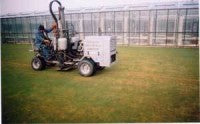Shattered compaction leaves glass intact.
Shattered compaction leaves glass intact.
By Carol Dutton

Owned by the Scotts Company, as part of their trial facilities at Levington Research Centre, Suffolk, this is a 42 unit multi factorial glasshouse used to develop new horticultural products for the Professional and home garden markets throughout northern Europe. Although the 800 sq metres of grass adjacent to the building had suffered from surface water retention for five or six years, the proximity of the glass prevented the installation of a new drainage system.
"Originally this grass area housed 18 amateur greenhouses which were destroyed in the gales of 87 and 88," remembers Scotts' Senior Technician Peter Vaughan, who has been with the company for many years. "Once the site was clear we used it to trial herbicides, which meant that following our research the ground had to be excavated 15 to 18 inches below the surface. We achieved this with a track digger and brought in new soil. For the first four or five years we had no problems, but gradually drainage deteriorated. We tried verti-draining and solid tining, but to no avail. After a heavy downpour we couldn't get on it, and the area developed moss and thatch. I believe that the surface aeration wasn't reaching the compaction pan 18 inches down, which had been caused by the track digger."
David Green, Terrain Aeration's MD who was contracted to do the job, is inclined to agree.
"Excessive retention of water is unusual on a site such as this because it sits on some of the driest, best drained but poorest soils in an area known as the "Sandlings" in East Suffolk," he explains. "Peter visited our stand at BTME and we confirmed that our machines used compressed air to relieve compaction to a depth of one metre. We started work with a safety margin of two metres between Airforce and the glasshouse, and found a highly resistant layer between two and three feet down, which needed 54 litres of 20 Bar compressed air to penetrate. Once we'd completed the first two rows working at two metre spacings, the machine was six metres away from the glass and the chances of damage were negligible."
Having injected dried, milled seaweed on the final air blasts to ensure the underground fractures remained open, and used over a kilo of Lytag to fill each of the probe holes, allowing easy vertical drainage to a depth of one metre, Terrain Aeration left site.
"We had some really heavy rain two or three days after the work was completed and the water disappeared from the surface," reports Vaughan. "Proof of success will come in the next few weeks, but watching the machine working I can't see why it should fail. I'm hoping that with the drainage problem solved, we'll be able to employ some sensible irrigation on here in the summer."
For further information on services provided by Terrain Aeration, call the company on Tel: 01449 673783
